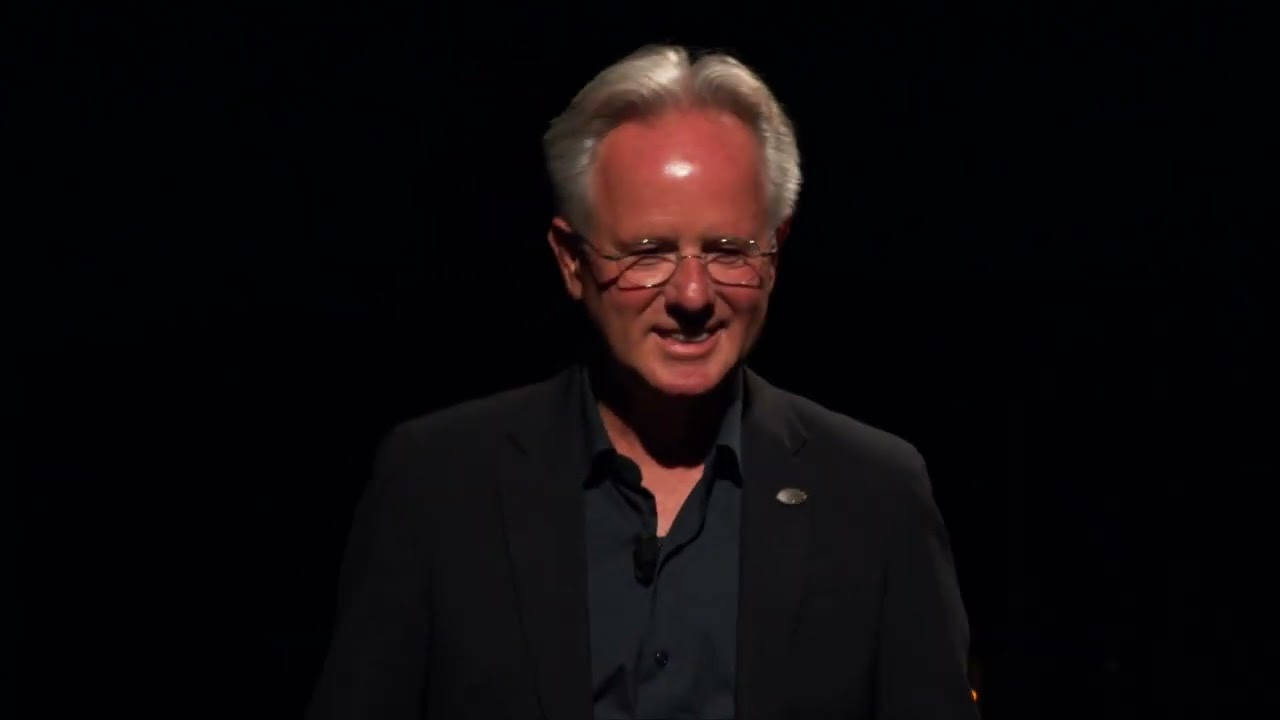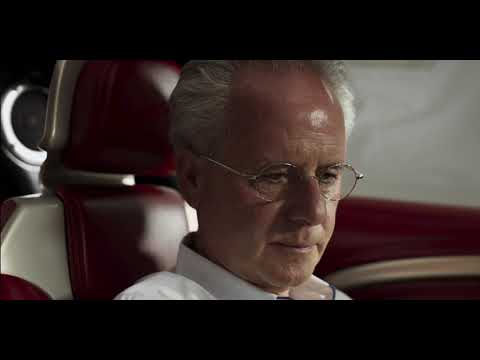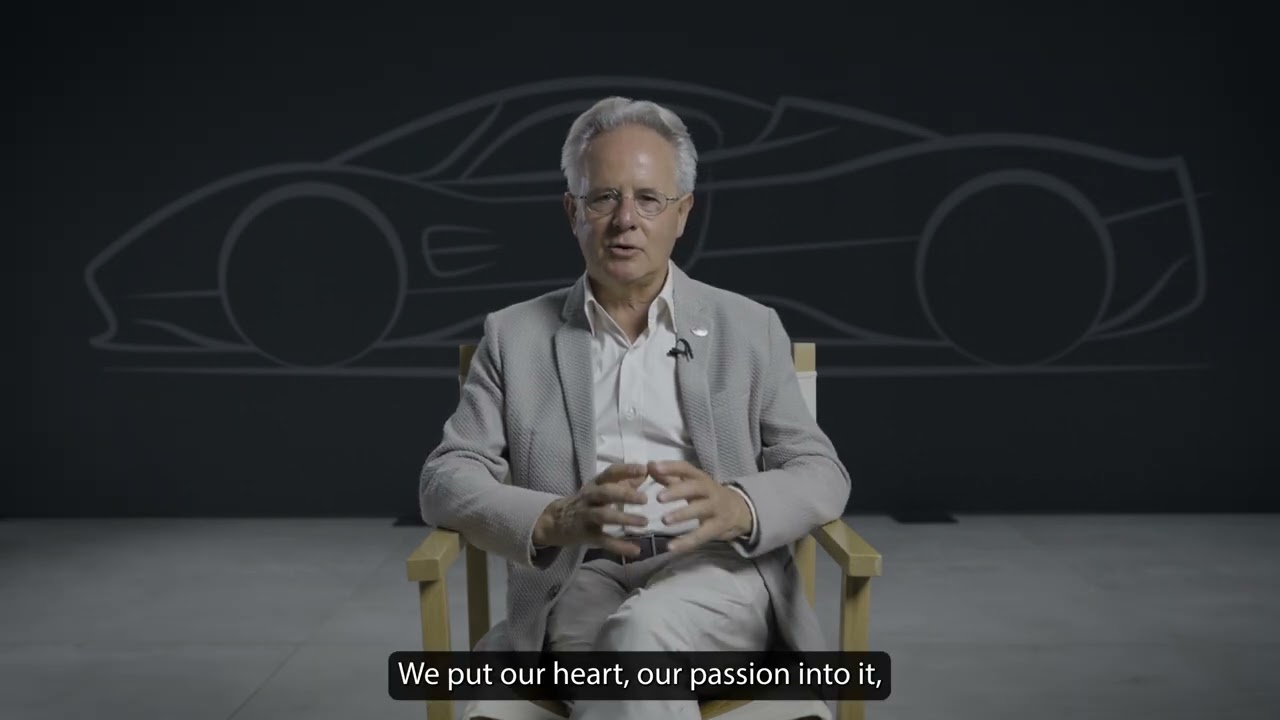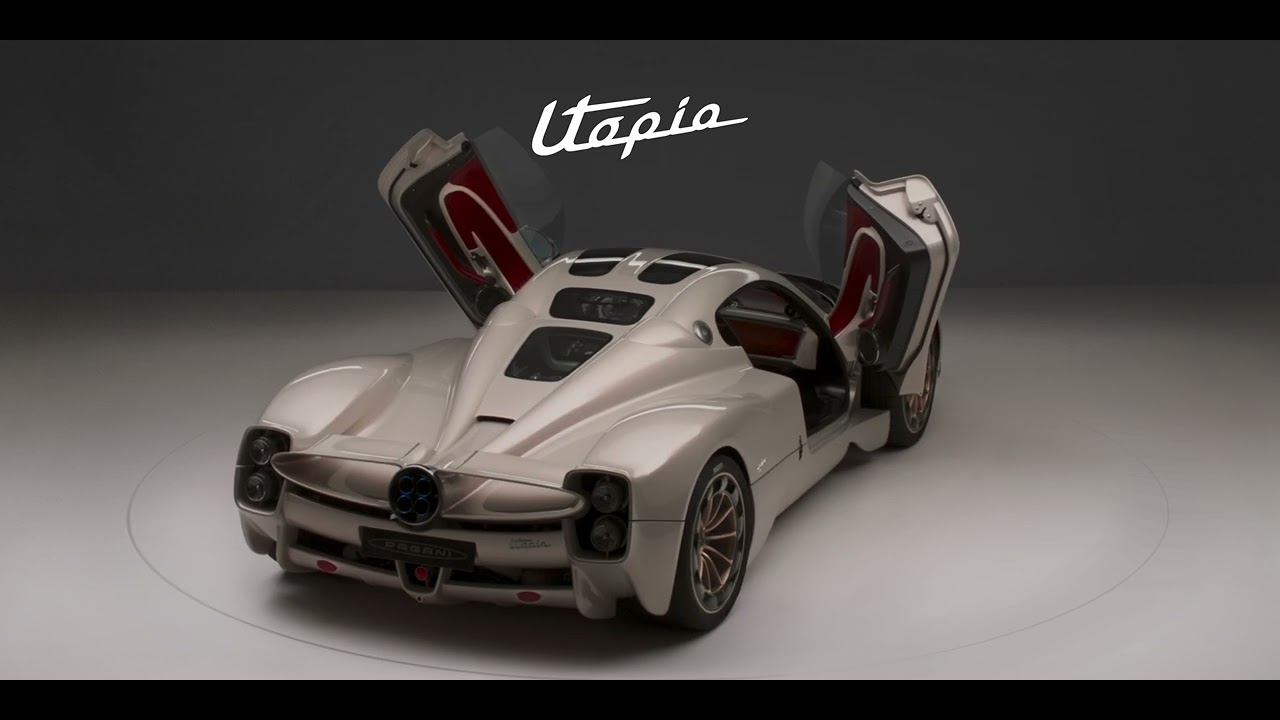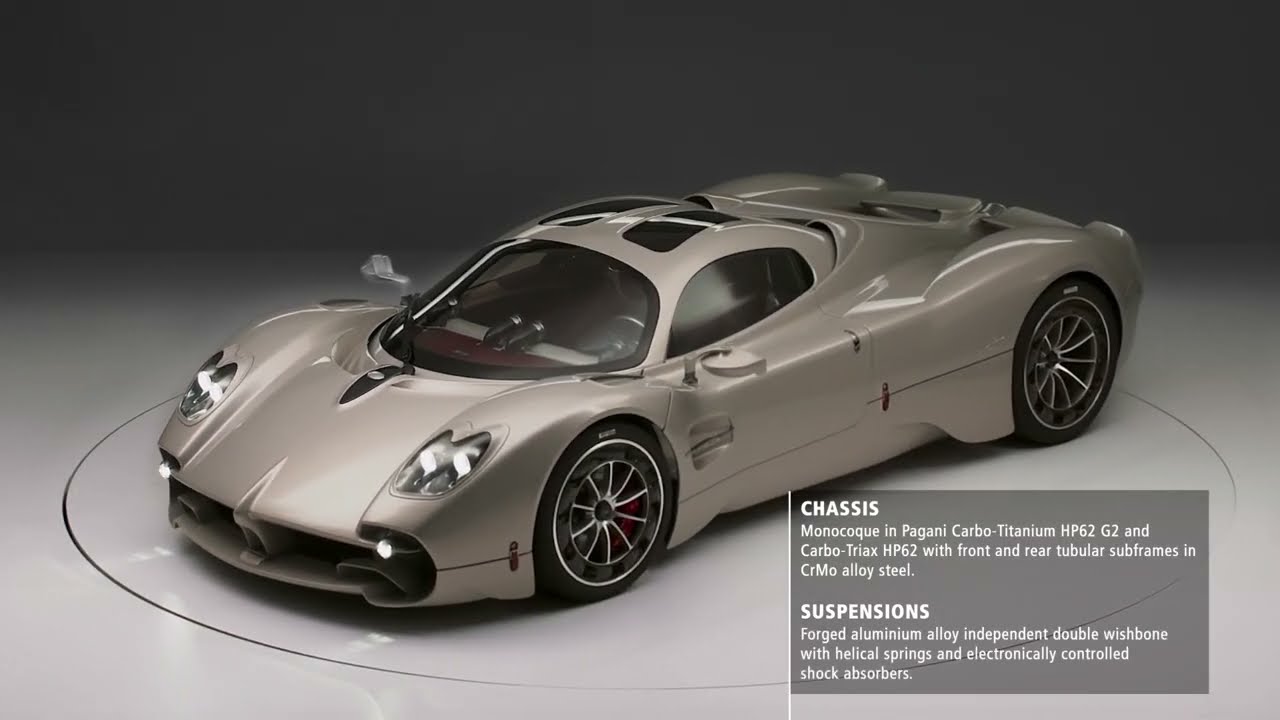The city of Milan hosted the world premiere of a brand-new Hypercar, the Pagani Utopia. A presentation accompanied by music and art. The principle of Art and Science has always underpinned Pagani Automobili’s creations and is the thread linking designer Horacio Pagani to Leonardo da Vinci. It lies at the heart of the temporary exhibition at which the new Hypercar was displayed together with six original drawings by the eclectic artist and unparalleled genius. The musical background was a composition played by the Symphony Orchestra of the Milan Conservatory, inspired by piano pieces composed by a young Horacio Pagani.
“More than four thousand stylistic drawings, ten scale models, one wind tunnel model, two 1:1 scale models and countless ideas, research and experiments on eight complete prototypes for a team effort that lasted more than six years. We put our passion, effort and sacrifice into creating something timeless and cutting-edge in terms of technology.
Horacio Pagani
After being completely absorbed by this strenuous creative process, the ideals represented by the project became so intimate to me, that any attempt to describe it would have seemed inadequate.
Almost by chance I came across an old article by Robert Puyal, in which he described the first Zonda in 1999 in a surprisingly insightful way, following a principle of simplicity and elegance similar to what I have sought from day one in the new project.
So I suggested to my colleagues in the communication department to invite him and let him narrate this new stage of our journey.”
Pagani, Act III
Horacio Pagani’s company is now in its third decade, and here is its third creation. The C8 project, the Zonda, began to establish the legend. The C9 project, the Huayra, built upon this on a global scale, integrating the use of active aerodynamics and Carbo-Titanium. What then, could its third model, codenamed C10, add? More power, increased performance, a better structure and aerodynamics? Absolutely, but what else? Above all, you need a goal.










Aims and ambitions
The alchemy of pleasure, the equation of beauty … What would be important for the next Pagani hypercar? Horacio Pagani certainly had his own ideas, but he asked his closest clients, those who eagerly await each of his creations, to express their wishes. They already had exceptionally fast and beautiful cars, what were they still missing? Three terms stood out almost each time they replied: simplicity, lightness and the pleasure of driving. In its development, the C10 project therefore went against the main trends of the time. No heavy batteries, no hybrid power, just a wonderful V12; no dual-clutch system, just a pure seven-speed manual or automated transmission. All this to ensure that the car would respond better than ever to its driver’s every action and work with them to be the purest form of driving, a ‘classic’ experience defined in new ways.

With a brief like this and such high ambitions, what name could be chosen for the car that would embody these principles? Utopia… For the philosopher Thomas More in 1516, Utopia was a place that did not exist, and ever since the name has been given to the idealized places of which we dream. But for those who make their own future, for creators, utopia exists, it is ‘merely’ a case of finding it!
What we see
Every Pagani begins with an aesthetic shock. Utopia radiates simplicity. It asserts itself straightaway, affirms and imposes its lines, which are so typical of Pagani but at the same time it is so different from anything they have offered us before. A shape that is more flowing and curvaceous. From the windscreen, with its rounded upper edges, to the details of its wings and bonnet, its softer contours give it a new expression, a new outline. A shape smoothed and refined over a long time, but which sticks in your memory from the first time you see it. The most difficult part of the process for Pagani has been to follow as closely as possible the original intention of creating a timeless design object, instead of one that follows the fashion of the period.

The new car has very few aerodynamic add-ons yet is more efficient than ever. Where some hypercars have a multitude of spoilers, Utopia incorporates the function of these appendices into its overall shape, achieving greater downforce and reduced drag solely by means of its design.

The details of its styling are few in number, but each is so carefully executed that it can be admired in its own right: technologically advanced, their shape is inspired by objects from the 1950s like the streamlined headlamps of Vespa scooters or the fittings of Riva speedboats. The forged wheels have a turbine-shaped carbon fiber extractor which draws hot air away from the brakes and reduces turbulence under the body. Mounted on carbon-ceramic discs, the brake calipers have a new, lightened design.

The role of Pirelli tires is to transfer the exuberant torque to the ground efficiently and bring the finishing touches to the car’s exceptional road feel, thanks to the unusually large 21” wheels in the front and 22” wheels in the rear, which triggered new creativity and distinguishing design freedom on the surrounding bodywork. The silhouette of Utopia can be seen on their sidewalls, demonstrating just how much they have been specially developed for this car.

The side mirrors, as if suspended in mid-air, thanks to the airfoil-shaped support are set apart from the body for better aerodynamic penetration, showing the meticulous optimization that was carried out on them in the wind tunnel. The rear lights float at the sides of the rear wings, set into the air extractors. Each part of them, so beautifully crafted, could be displayed in the window of a jeweler’s shop.

The titanium quad exhaust, a personal monument and signature of the brand, is still present. It has a ceramic coating, in order to dissipate the heat efficiently, but still sets the weight just above 6 kilograms for the complete system.

A glance to the future, a tribute to the past
A car may be compared to a sculpture, but opening the door changes everything; a sculpture, yes, but one you can sit in. The interior of Utopia is even more original, if that is possible, than its exterior shape.

Neither modern nor retro, it is timeless. There are no screens apart from the minimal display in front of the driver; big screens would have been easier to fit and would have saved a lot of effort in the design, but it would have taken away much of the beauty. All the instruments are purely analog and each of the easy-to-read dials subtly reveals part of its mechanism as if it were revealing the skeleton movement.

For Pagani, every component needed for the car to function is an opportunity to be creative. Even the steering wheel has been reinvented: it is fashioned from a solid aluminum block, from the spokes and hollow rim to the steering column boss, which contains the airbag. The pedals are also made from a single block of metal, while the gear lever mechanism is still exposed but more sophisticated than ever. All this with proper obsession paid to ergonomics, efficiency and ease of access.

What makes it what it is
To reach this very simple final shape, the process has never been as complex. For six years, from the first sketches and computer calculations until the definitive shape was frozen for the carbon fiber molds, its internal airflows were perfected through endless hours of research in the wind tunnel and countless changes, one touch at a time. Utopia takes advantage of the mysteries of aerodynamics to maximize sure-footed handling and stability at any speed, however high. Its active aerodynamics, combined with the electronically controlled shock absorbers, ensure the optimum dynamic behavior in all driving conditions. The double-wishbone suspension, made from aerospace aluminum alloy, benefits from the lengthy development work carried out on the R, the track-only version of the

Huayra. But Utopia, a car designed for road use, can cope with surfaces for daily use.
The carbon monocoque used on previous Pagani models sets the standard in terms of its strength, lightness and build quality. Pagani has chosen to consolidate its existing strengths, to improve how its fibers are woven and to constantly invent new composite materials such as Carbo-Titanium and Carbo-Triax. On top of that, a new type of

A-class carbon fiber has been developed specifically for aesthetic applications such as the bodywork, providing 38% of additional stiffness with the same density.

A high-performance car must not only please its buyer, but support them and provide all the safety they require, without their need to ask or worry about it. Many exemptions are granted to very low-volume manufacturers, but Pagani made it a point of honor – once again – to build its cars and meet the most stringent regulations in the world, in every respect, starting with safety. Utopia passed more than 50 severe crash tests, from development to pre-tests and homologation approval, to reach its global certification.

At your service
The Pagani V12 engine, a 6-liter biturbo specially built by Mercedes-AMG for Pagani, is the result of an enormous development work: it delivers 864 bhp and, above all, a prodigious 1100 Nm of torque. It revs higher and is both more flexible and more powerful while meeting the most stringent emissions regulations, including those in force in California.

For the transmission the choice was a philosophical one. It would not be a dual-clutch transmission which is efficient, but heavy and robs the driver of the ability to set the pace of the car’s acceleration. Instead, Pagani turned to the most prestigious motorsport and high performance automotive transmission manufacturer, Xtrac, to develop the quickest shifting gearbox with helical gears possible. It is compact, light and transversely mounted for an optimized center of gravity.

Moreover, in order to best match the wishes expressed by Pagani enthusiasts, its aficionados, a virtual manual would not be acceptable so a real seven-speed manual transmission has been developed. It was not an easy task to design such a gearbox with synchronizer rings and a mechanism able to handle 1100 Nm of torque adequate for a pure manual application, but it was an essential requirement for Utopia.

However intelligent automatic transmissions may have become, nothing can replace the driver’s own mastery of the gearchanges: the prevailing logic is his alone, each change up or down is totally unique and depends solely on his decision and good judgment, the exact combination of circumstances, the nature of the road and the mood of the moment.

The starting point
As we discover his latest work, it is the path taken by its creator that fascinates us. Horacio Pagani builds the cars he has dreamt of. And it is to fulfill his highest aspirations, those closest to the impossible, that, as a very conscientious engineer, he seeks to serve the dreamer. In the land of dreams, you need a guide: the great Leonardo da Vinci has always been a crucial figure for Pagani. It is under Leonardo’s aegis that he has always believed that it is possible to combine art and technology.

Can you think of any more demanding mentor? An artist and an inventor, Leonardo, one of the greatest portrait painters of all time, was also interested in anatomy. It is not the case for Horacio to compare himself to the Florentine genius but of following his path: Leonardo constantly combined technical inspiration with his love of beautiful shapes.

Horacio Pagani is an artist, the car is his preferred way of expressing himself. When he draws something, however beautiful it is, the shape he creates is the result of the function it will perform. For him, a shape cannot be elegant if it is technically incorrect. And when the technical difficulty has been overcome, its beauty can be found in its solution.

Horacio has always gone about things in the same way, that is just how he is: the creativity and the act of solving real problems, take the shape in him of an expression of painting or poetic harmony. He has always been a composer, and for a long time as a designer he was a soloist, but now he has become a conductor and has learned to see his ideas carried out by his team – young men and women who will then contribute with their own ideas to the common masterpiece, and on which he can put his signature with pride.

New strengths
From its origin, the situation has changed considerably; the firm was self-sufficient in 1999, with just 25 employees in total and so much to be done; but this is no longer appropriate. Pagani, a function-focused company, remains essentially a family-sized business but today employs 180 staff. Engineers specializing in all fields, designers and highly qualified technicians occupy the Art & Science Research Center, where the Zondas originally came into being, whereas the new facility is home to the production process. Turning out 50 cars a year, it is closer to a sartorial atelier than an assembly line.

Nearly 25 years ago, the Zonda was designed and built by a very small team with few resources. Imagine what an intuition can grow into, nurtured and developed by the new strengths Pagani Automobili now possesses. Whatever the decision, whatever the direction its creative ideas may take, this little company is capable of realizing them, quickly and well, with an unrivaled standard of quality. Its design, prototyping, development and production work is worthy of the top racing teams, but at the service of limited-production cars. The first series of Utopia coupés, which have already been assigned to privileged enthusiasts, will be built in 99 units.

Each car represents the natural and necessary convergence of multiple disciplines, each of which combines technology and aesthetics. It is the mastery of this process which Pagani has taken to new heights of excellence.Pagani’s story continues, Pagani’s work goes on…
Robert Puyal
Pagani Utopia Technical Specifications
- DRY WEIGHT: 1.280 Kg (2822 lb)
- POWER: 864 HP (635 kW) at 6000 RPM at 18 °C
- TORQUE: 1100 Nm from 2800 RPM to 5900 RPM
- ENGINE: Pagani V12 60° 5980 cc twin turbochargers, developed on a bespoke basis by Mercedes-AMG
- GEARBOX: Pagani by Xtrac 7-speed transversal AMT (Automated Manual Transmission) or pure manual, with electro-mechanical differential
- CHASSIS: Monocoque in Pagani Carbo-Titanium HP62 G2 and Carbo-Triax
- HP62: with front and rear tubular subframes in CrMo alloy steel
- SUSPENSIONS: Forged aluminum alloy independent double wishbone with helical springs and electronically controlled shock absorbers
- BRAKES: Pagani by Brembo 4 ventilated carbon-ceramic discs brake unit, 410×38 mm with 6 pistons monolithic calipers at the front and 390×34 mm with 4 pistons monolithic calipers at the rear
- WHEELS APP: forged monolithic aluminum alloy, 21” at the front and 22” at the rear
- TYRES: Pirelli PZero Corsa 265/35 R21 at the front and 325/30 R22 at the rear; Pirelli SottoZero for driving in low temperatures

















































